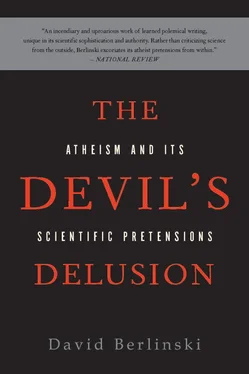There is finally the claim that the universe is a closed causal system, the triplet of its three vaguely technical terms suggesting something more substantial by way of a definition. But to say that the universe is a causal system is hardly an improvement on the thesis that effects have causes, and if the universe is everything that there is, then to say that it is closed is only to observe that there is nothing beyond everything.
This is not a thesis calculated to set the blood racing.
There is nothing in nature, ancient Greek atomists said, but atoms and the void, and while this claim has over the centuries been refined, it remains deep down the same. The end of the matter is matter. Materialists have always hoped that by going downward, they would at last reach the ultimate level of analysis and so the place where Nature reveals her ontological essentials by means of a finite number of elementary particles. This is a matter of faith. It is entirely possible that there may be as many elementary particles as there is funding available to investigate them.
The advantage of materialism as a doctrine is that it sanctions an easy argument for atheism. Either the Deity is a material object or he is not. If he is, then he is just one of those things, and if he is not, then materialism could not be true. But if God is just one of those things, what is his interest? And if materialism is false, why are we arguing?
Whatever the merits of this argument, the world of matter revealed by the physical sciences does not serve to endow materialism with a familiar face. The universe in its largest aspect is the expression of curved space and time. Four fundamental forces hold sway. There are black holes and various infernal singularities. Popping out of quantum fields, the elementary particles appear as bosons or fermions. The fermions are divided into quarks and leptons. Quarks come in six varieties, but they are never seen, confined as they are within hadrons by a force that perversely grows weaker at short distances and stronger at distances that are long. There are six leptons in four varieties. Depending on just how things are counted, matter has as its fundamental constituents twenty-four elementary particles, together with a great many fields, symmetries, strange geometrical spaces, and forces that are disconnected at one level of energy and fused at another, together with at least a dozen different forms of energy, all of them active.
This is not an ontology that puts one in mind of a longshoreman’s view of the material world. It is remarkably baroque. And it is promiscuously catholic. For the atheist persuaded that materialism offers him a no-nonsense doctrinal affiliation, materialism in this sense comes to the declaration of a barroom drinker that he will have whatever he’s having, no matter who he is or what he is having. What he is having is what he always takes, and that is any concept, mathematical structure, or vagrant idea needed to get on with it. If tomorrow, physicists determine that particle physics requires access to the ubiquity of the body of Christ, that doctrine would at once be declared a physical principle and treated accordingly.
The scientific method has acquired a certain hold on the popular imagination. Every adult remembers something about the scientific method from high school classes; it figures prominently in textbooks with such titles as Reasoning Together, and it is a polemical bruiser in its weight class, useful under circumstances when members of the scientific community are persuaded they are under attack. It is then that the determination is made that members of the public have failed to understand the scientific method or properly to revere it. No effort need be made actually to exhibit the method or tie it to an argument.
All of this provides a richly satisfying spectacle.
Here is one account, an Internet staple. To apply the scientific method
1. Observe some aspect of the universe.
2. Form a hypothesis that potentially explains what you have observed.
3. Make testable predictions from that hypothesis.
4. Make observations or experiments that can test those predictions.
5. Modify your hypothesis until it is in accord with all observations and predictions.
Not a single one of these five sentences makes the slightest sense, but rather than go through the list, let me observe only that it is portable in its power, and applies pretty much to any human undertaking.
“Through extensive observation, I found a Common Denominator among all Golfers, and once I finally realized what that Common Denominator was, I just couldn’t believe how ‘obvious’ and simple it all was. As in any puzzle or ‘discovery,’ the idea was right in front of my eyes all the time!
“The Common Denominator I discovered was that all golfers who break 80 regularly are good, or at least fairly good at a certain Element in the golf swing, and all golfers who don’t break 80 are bad at that same thing. From this simple observation came the obvious conclusion that this Element was the first and most important thing that needed to ‘be in’ and to be learned in order to shoot in the 70s!
“This method is based upon this observable fact (Common Denominator). So the next thing to do was to test this idea to see if this method really worked. And the answer? Yes, it did, and in Spades! I saw changes in minutes and hours, and huge big smiles on people’s faces. Handicaps were being cut in half within weeks!”
I will draw down the current of charity over this scene. Golf has no method beyond the trivial.
Neither does science.
What remains of the ideology of the sciences? It is the thesis that the sciences are true—who would doubt it?—and that only the sciences are true. The philosopher Michael Devitt thus argues that “there is only one way of knowing, the empirical way that is the basis of science.” An argument against religious belief follows at once on the assumptions that theology is not science and belief is not knowledge. If by means of this argument it also follows that neither mathematics, the law, nor the greater part of ordinary human discourse have a claim on our epistemological allegiance, they must be accepted as casualties of war.
Declarations of this sort have been common in the history of philosophy since the eighteenth century. In An Enquiry Concerning Human Understanding, David Hume argued that “if we take in our hand any volume; of divinity or school metaphysics, for instance; let us ask, Does it contain any abstract reasoning concerning quantity or number? No. Does it contain any experimental reasoning concerning matter of fact and existence? No. Commit it then to the flames: For it can contain nothing but sophistry and illusion!” Analytical philosophers have been eager to commit books to the flames ever since, rather an odd vocational choice, all things considered. Whatever the vigor with which Hume advanced his views, arguments such as his when self-applied self-destruct. Hume’s remarks, after all, contain neither “abstract reasoning concerning quantity or number” nor “experimental reasoning concerning matters of fact and existence.” They are what they seem, and that is at once arrogant and uninteresting.
The attempt to find an argument powerful enough to paralyze distasteful doctrines, while remaining insusceptible to its own effects, has continued into our time. In his well-known essay “Two Dogmas of Empiricism,” W. V. O. Quine argued that the distinction between science and philosophy was an illusion. Philosophers were pleased since Quine appeared to offer the access to a form of prestige that previously they had been denied. If there is no distinction between science and philosophy, they reasoned, then we must be scientists. That they might by the same logic be nothing was an alternative that did not receive wide favor. Physicists, on the other hand, seemed remarkably unenthusiastic about welcoming philosophers as fellow scientists. “The philosphers,” Richard Feynman observed, “are always on the outside making stupid remarks.” Critics observed—correctly—that Quine’s argument seemed to affirm what it was most concerned to deny. In arguing that there was no distinction between science and philosophy, Quine was arguing as a philosopher, and he was making a philosophical argument. If this is science, anything is. And if it is not, so much the worse for the philosophers, who once again would appear to be “on the outside making stupid remarks.”
Читать дальше












